Robincroft
Introduction
Text-to-speech Audio
This historic Nashville brick home was built in 1908 and named "Robincroft" by its first owner, Thomas M. Robinson. Robinson was the head of a firm that manufactured buggies and carriages. The Robinson family owned the property for over eight decades before selling to a guitarist, who sold the house to the Demonbreun family soon afterwards. The family spent years renovating the house and turned it into a bed and breakfast called the Timothy Demonbreun House. The property was sold in January 2021. Robincroft became a National Register of Historic Places listing in 1978.
Images
Detail of 2014 photo of Robincroft /T. Demonbreun House (nyttend)
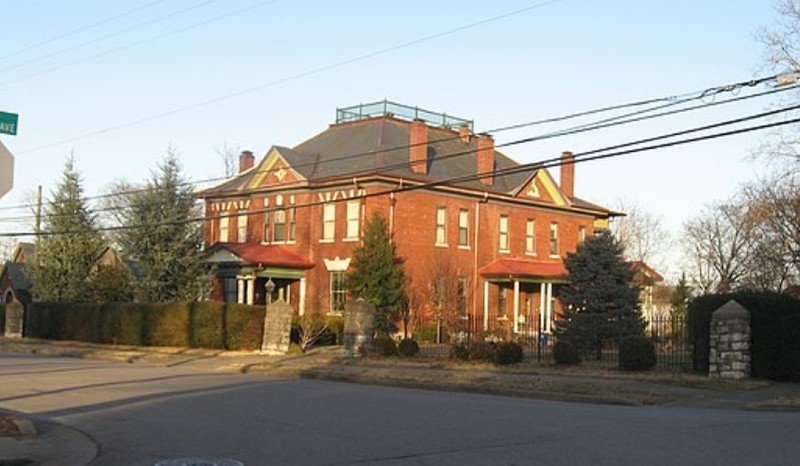
South and east sides of Robincroft in 1977 photo for NRHP nomination (David Paine)
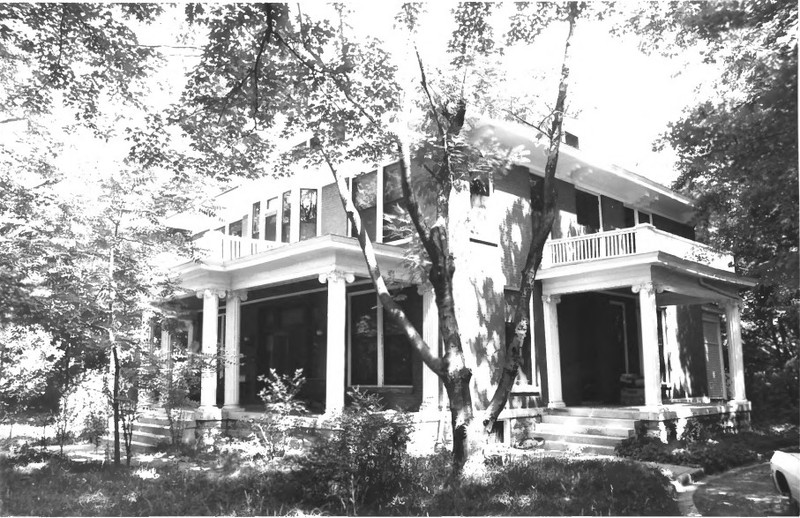
View of south elevation of Robincroft in 1977, facing northeast (David Paine)
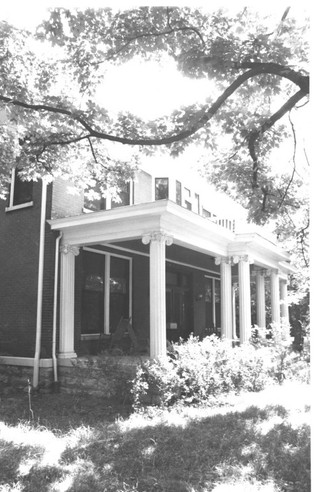
Detail of ceiling & light fixture at Robincroft; wall stenciling in background (David Paine 1977)
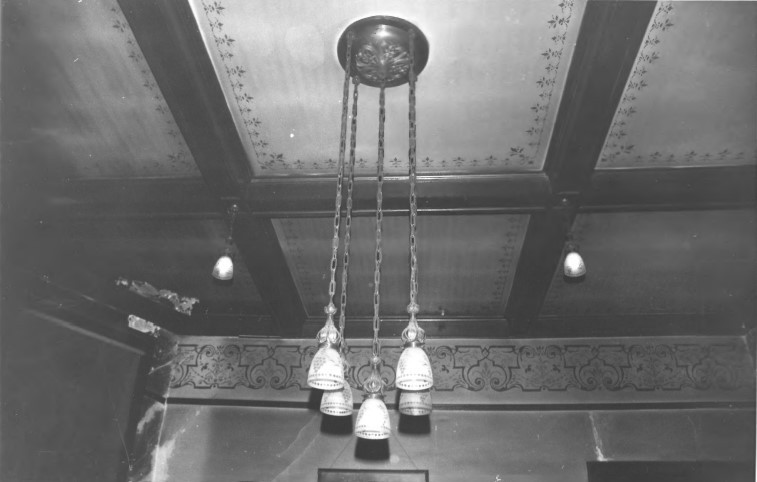
Robincroft (green arrow) on 1914 Sanborn map (Vol. 2 p. 243)
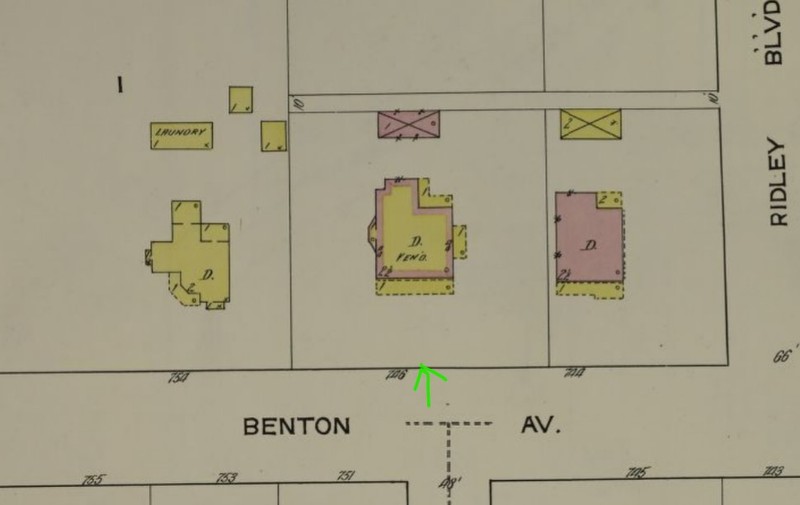
Backstory and Context
Text-to-speech Audio
Robincroft was constructed for Thomas M. Robinson and his second wife Annie. Thomas was born in Marshall County, Tennessee and was the president of the Robinson McGill Carriage Company. He had previously been president of the Robinson McGill Manufacturing Company of Shelbyville, Tennessee, but his interest in the firm was bought out by W.J. McGill of Shelbyville in 1907; McGill also purchased Robinson's interest in the Sylvan Cotton Mills in Shelbyville. While buggies were the company's prime offering, they also manufactured carriages. The company started in Shelbyville, but the buggy factory was destroyed by fire in 1907. The company built a new plant in Nashville in 1907 to 1908, where they planned to produce about 1,500 to 2,000 buggies and carriages per year. The new factory building, converted into a paint store by the 1970s, was close to the house (201 First Ave. S.). The buggy plant in Nashville closed in the mid-1910s but reopened in May 1915; the company also bought land in Fayetteville, Tennessee in 1915 where they planned to build a new buggy plant.
Annie Robinson helped design Robincroft and was responsible for the design of the stenciling on the first-floor walls. The 2.5-story house is actually wood frame covered with a brick veneer. Also on the lot by 1914 was a 1-story brick carriage house/ garage along the rear lot line, by an alley. In 1910, Thomas (age 43), shared the new home with Annie (35); five children or stepchildren (18 to 7); and an African American servant named Vina Jones (35). Mrs. Robinson's daughter and only child from her first marriage, Anita Williams, inherited the house; she was born around 1896. Miss Williams still resided in the house in 1977 when it was documented for listing in the National Register. The house was one of the first of its era to be nominated and was notable for the high state of preservation of the original oak woodwork, stenciling, hardware, and light fixtures.
Robincroft stayed in the family until Williams, or her estate, sold it in 1993 to Steve Cropper, a guitarist known for his work in "The Blues Brothers." A few years later, Richard and Rhonda Demonbreun purchased Robincroft and spent years renovating the house and grounds. They turned the house into a bed-and-breakfast and renamed it for Richard's ancestor and early explorer of Nashville, the Timothy Demonbreun House. The Demonbreuns offered a home-cooked breakfast with eggs supplied by their backyard chickens. A basement cistern has been turned into a wine cellar. The 7-bedroom, 6.5-bath house with 9,150 square feet and an in-ground swimming pool was listed at auction in 2000, but no bids reached the minimum amount desired by the owners. In January 2021, the property was sold for over $1.5 million.
Cite This Entry
Paonessa, Laurie and Clio Admin. "Robincroft." Clio: Your Guide to History. October 12, 2022. Accessed April 21, 2025. https://theclio.com/entry/157598
Sources
Anonymous. Untitled. Spokesman of the Carriage and Associate Trades. August 1st, 1907. 351 - 351.
Anonymous. Untitled. Spokesman of the Carriage and Associate Trades. September 1st, 1907. 389 - 389.
Anonymous. Southern. Spokesman of the Carriage and Associate Trades. October 1st, 1907. 406 - 406.
Anonymous. Wood Specialties: Items from Here and There. The Barrel and Box. September 1st, 1907. 57 - 58.
Anonymous. Vehicle News of Nashville, Tennessee. The Carriage Monthly. May 1st, 1915. 52 - 52.
Anonymous. General Manufacturing: Southern States. American Machinist. November 25th, 1915.
Fox, David A. Historic Waverly mansion Robincroft to be auctioned, Nashville Post. June 23rd, 2000. Accessed October 4th, 2022. https://www.nashvillepost.com/business/development/historic-waverly-mansion-robincroft-to-be-auctioned/article_82f103ee-bcb4-54c5-a62b-62ac80b3accc.html.
Paine, David H. NRHP nomination of Robincroft, Nashville, Tennessee. National Register. Washington, DC. National Park Service, 1977.
Redfin. 746 Benton Avenue, Nashville, TN 37204, October 1st, 2022. Accessed October 4th, 2022. https://www.redfin.com/TN/Nashville/746-Benton-Ave-37204/home/60685979.
U.S. Census. Household of Thomas Robinson at 717 Benton Avenue, Nashville District 76, Tennessee. Dwelling 350, family 363.. Washington, DC. U.S. Government, 1910.
https://en.wikipedia.org/wiki/Robincroft#/media/File:Robincroft_on_Benton.jpg
National Park Service (NPS): https://npgallery.nps.gov/AssetDetail/NRIS/78002583
NPS: https://npgallery.nps.gov/AssetDetail/NRIS/78002583
NPS: https://npgallery.nps.gov/AssetDetail/NRIS/78002583
Library of Congress (LOC): https://www.loc.gov/item/sanborn08356_006/

